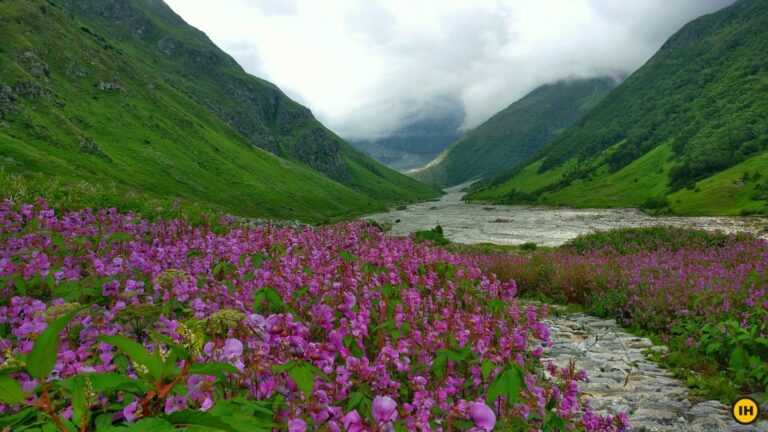
INTRODUCTION:
The stunning valley, which ranges in elevation from 3,300 to 3,650 metres, is a veritable heaven for outdoor enthusiasts. It stretches for around 87 square kilometres, beginning around 6 kilometres from the hamlet of Bhuindhar. A wide variety of wildflowers may be found across the valley, making it one of the best places to see them. Through the lush valley, the Pushpawati River winds. From the middle of June to the beginning of September, the valley is filled with the fragrance of exotic flowers. The region was designated a National Park in 1982, and it is home to about 520 different kinds of flowering plants. This national park is home to a wide diversity of flora and fauna, including endangered species like the Himalayan black bear, musk deer, brown bears, Bharal, and birds and butterflies.
Highlights of a Trip to the Valley of Flowers National Park
Haridwar, Rishikesh, Joshimath, and the Gurudwara of Hemkund Sahib, as well as numerous other holy sites, rivers, lakes, and mountains covered in snow.
A low-altitude hike with vast canyons, open landscapes, and vivid hues. Amazingly varied landscapes.
Mountains covered with snow, rushing waterfalls, verdant fields, and a rainbow of wildflowers.
rare peek of the locals’ ancient culture.
Spending the night at a hotel or B&B.
When to Go to the Valley of Flowers trek for the Best Experience
Through the months of June and July: During these months, visitors to the Valley of Flowers can marvel at waterfalls and stunning glaciers. The month of April is ideal since it rarely if ever rains and the flowers are just beginning to bloom.
In August and September: As snow starts melting in May and new plants starting growing and grow up till August. From now until about the middle of August, there will be a profusion of flowering flowers. August and September are the best months to visit valley of flower since there are the most blossoms. All the plants and flowers are starting to dry up and drop their seeds for the coming season.
How do you get to the Valley of Flowers?
High in the West Himalayas is where you’ll find India’s Valley of Flowers National Park. The area is well-known for the abundance and variety of indigenous alpine flowers that may be found in its meadows. The state of Uttarakhand is where you’ll find it. The Asiatic black bear, snow leopard, brown bear, and blue sheep are just few of the unique and endangered species that call this region home. To the east, at Nanda Devi National Park, you’ll find a rough mountain scenery that contrasts beautifully with the soft landscape of Valley of Flowers National Park. They represent a distinct transition zone between the mountain ranges of Zanskar and the Great Himalaya.. The park covers over an extent of 87.50 km². The Nanda Devi Biosphere Reserve (223,674 ha) encompasses both parks and is further encircled by a buffer zone (5,148.57 km2). Since 2004, this Reserve has been a part of the UNESCO World Network of Biosphere Reserves.
Valley of Flowers Trek (Detailed Itinerary)
Day 01\sDelhi – Haridwar – Rishikesh
Other Benfits (On Arrival) (On Arrival)
meal
Breakfast\stransport
Transfers\sstar hotel
Stay Included
Get yourself to the Delhi train station by 06:50 hrs so that you can board the air-conditioned train bound for Haridwar. Guests will be met upon arrival in Haridwar and transferred to their hotel in Rishikesh. Nighttime is a time of relaxation and fun. Staying in a hotel for the night.
Day 02\sRishikesh – Joshimath (245 kms / 8-9 hrs) We’re at a height of 5,910 feet (1890 metres).
Have breakfast and get in your car early since you will be driving from Devprayag to Joshimath. Stop beside the holy confluence of the Bhagirathi and Alaknanda rivers at Devprayag on the way. Get to Joshimath at night and settle into your hotel. The hotel stay included dinner and bedtime.
Three day hike from Oshima to Govindghat (22 kilometres, one hour). Ghangaria, at an altitude of 1828 metres, is located 14 kilometres (or 3 to 4 hours) away. 3048 mts
Today, get set for a drive to Govindghat after taking an early breakfast. Our journey begins in Govindghat, and from there we will hike to other locations. Starting from here, the path to Ghangaria is relatively easy going. Get to Ghangaria, where you may settle into your hotel. The hotel stay included dinner and bedtime.
Day 4: Travel from Ghangaria to the Valley of the Flowers and back to Ghangaria (5 kilometres, one way; 4 to 5 hours). Height: 3,352 to 3,658 metres
Walk from Ghangaria to the Valley of Flowers (at an elevation of 3858 m) after breakfast. Return to Ghangaria after appreciating the valley’s natural splendour. The hotel stay included dinner and bedtime.
Day 5: Drive from Ghangaria to Hemkund and back again (2-3 hours and 5 kilometres). Height in Meters: 4329
Our journey to “HEMKUND SAHIB” is a 7-kilometer trek that will begin bright and early in the morning. A major religious centre for the Sikh religion. This afternoon, you’ll make the descent to Ghangaria, where you’ll spend the night. The evening is at your leisure, perfect for unwinding.
Day 6: Ghangaria to Govind Ghat to Joshimath to Rudraprayag (130 kilometers/five to six hours).
Drive to Srinagar via Joshimath, Chamoli, and Rudraprayag after an early morning climb down to Govind Ghat. Enter your hotel upon arrival. Spend the night in a motel after dinner.
Day 7: Rudraprayag, Haridwar, and Delhi
Get in the car and head to Haridwar after breakfast. Stop by Devprayag on the route (Confluence of river Bhagirathi and Alaknanda; from here the holy Ganges start). At 18:15 hours, have a transfer waiting to take you to the Haridwar train station, where you may catch the train back to Delhi. By 22:45 local time, you’ll have made it to Delhi.